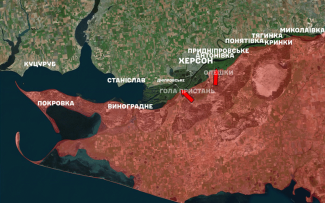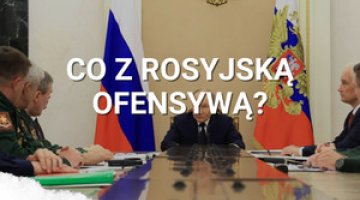Russian advances in Zaporizhzhia Oblast. Day 1364 of the war

![]()
The Russians continue their active efforts to close in on the Pokrovsk conurbation. They are intensifying their advances east of the city near Udachne and Kotlyne, as well as in the directions of Krasnyi Lyman–Rodynske and Chervonyi Lyman–Myrnohrad. At the same time, they are clearing and demining roads in the immediate tactical rear in order to bring additional units into the fight, including those reinforced with armoured vehicles and other means of transport (motorcycles, buggies, modernised passenger cars, etc.). To hinder these activities, on 15 November, Ukrainian troops attempted to destroy the road leading to the village of Selidove, south of Pokrovsk.
Taking advantage of rainfall and fog, Russia made progress near Novopavlivka. The occupying forces managed to establish a pontoon bridge across the River Vovcha between Yalta and Dachne, enabling them to transport a significant amount of equipment. Ukrainian forces discovered the operation too late, which allowed Russia to occupy bridgeheads in the southern part of the town.
On 12 November, the Russian army drove the Ukrainians out of Rivnopillia and Yablukove in Zaporizhzhia Oblast, having previously captured Novouspenivske and Nove. It thus moved closer to the logistics route connecting Huliaipole with Pokrovske (not to be confused with Pokrovsk) and will try to continue its advance towards Varvarivka in order to achieve the possibility of operationally encircling Huliaipole from the north-east.
The situation is also difficult for Ukraine in the Lyman direction, where the enemy has intensified its offensive operations between Lyman and Yampil, towards Dibrova and Stary Karavan. Russia’s goal is to take full control of the Lyman-Siversk road and cut off the latter from communication routes.
However, Ukraine managed to halt the further advance of Russian forces in Kupiansk. The current situation in this city is dynamic and the most volatile on the entire front. Both sides report that they have cut off part of the enemy’s forces from the rest of their group.
![]()
Russia continues to launch drone and missile strikes on energy facilities and residential infrastructure in Ukraine. On the night of 13–14 November, they launched a large-scale air strike on Kyiv, using hundreds of drones and missiles. At least seven people were killed and at least 29 were injured. According to the mayor of the capital, at least 11 multi-storey buildings were damaged. According to the State Emergency Service, a hospital, a school and sports facilities were also damaged. Fragments of an Iskander-M ballistic missile fell on the Azerbaijani embassy.
On the same night, Russia attacked Sumy, Mykolaiv, Kherson, Chornomorsk and Chuhuiv with drones. The strikes on Mykolaiv and Sumy damaged industrial infrastructure. At least six people were injured, three of whom are in a serious condition.
On the night of 15 November, the occupying forces carried out an air strike on Dnipro. One of the targets was a warehouse belonging to Optima-Pharm, one of the two largest pharmaceutical distributors in Ukraine. The destroyed facility served the southern regions of the country, and the strike destroyed 20% of the monthly supply of medicines.
On the night of 16–17 November, Russia attacked the energy infrastructure of the Kharkiv, Sumy, Chernihiv, Odesa and Donetsk oblasts. Among other targets, the attack hit the Danube port of Izmail, where infrastructure and several civilian vessels near the quay were struck, including a Turkish tanker carrying 4,000 tonnes of LNG. The explosion forced the Romanian authorities to evacuate residents of the town of Plauru on the other side of the border.
On the night of 17–18 November, Russia carried out a massive drone attack on Dnipropetrovsk Oblast and its capital, Dnipro. A transport company facility, a petrol station, a two-storey commercial building and commercial premises in the city were damaged. The shock wave also damaged the locomotive repair hall and the station building. At least two people were killed and several were injured.
![]()
On 13 November, the Main Military Intelligence Directorate (HUR) reported a sabotage operation on the Trans-Siberian Railway near Sosnovka in Khabarovsk Krai. The detonation of an explosive device reportedly derailed a freight train and damaged the tracks, halting traffic on a logistics artery used to transport weapons and ammunition, including from North Korea.
The Russian Ministry of Defence reported that 130 Ukrainian drones were shot down on the night of 12–13 November in the Kursk, Belgorod, Voronezh, Oryol, Tambov, Rostov, Bryansk, Tula, Moscow oblasts, Krasnodar Krai, the Black Sea and occupied Crimea. The General Staff of the Armed Forces of Ukraine reported that Ukrainian forces carried out a series of attacks on enemy territory during this time. According to Kyiv, the targets successfully hit in Crimea included the Morsky Naftovy Terminal oil storage facility, a helicopter airport, and bases and training grounds for unmanned aerial vehicles at the Kirovske air base, as well as an air defence radar station in the Yevpatoria area. In the temporarily occupied territory of Zaporizhzhia Oblast, an oil depot near Berdiansk and forward army command posts were hit.
Another massive Ukrainian drone attack took place a day later. In Novorossiysk, an oil storage facility at the Sheskharis transshipment complex was damaged. Russia stated that unspecified “civilian infrastructure” had been damaged as a result of the strike, while according to information from the Ukrainian services, a large fire broke out at the port terminal, resulting in the suspension of port operations for two days and the introduction of a state of emergency in the city itself. According to Reuters, oil exports were halted and the pipeline monopoly Transneft suspended oil deliveries. In addition, four S-400 Triumph launchers and two radars located near the city were reportedly destroyed as a result of the combined drone and missile attack.
![]()
On 17 November in Paris, Presidents Volodymyr Zelensky and Emmanuel Macron signed a declaration of intent for Ukraine to purchase up to 100 Rafale fighter jets, along with 600 AASM Hammer glide bombs and eight SAMP/T medium-range air defence batteries with Aster 30 Block 1 NT missiles for combating ballistic missiles. It was also announced that there would be another package of French military aid by the end of the year.
The document provides for the conclusion of executive agreements within three years and the completion of deliveries by 2035. The project has not yet received funding – Kyiv is counting on the EU's planned €140 billion reparations loan, using frozen Russian assets. In addition, the capacity of the Dassault corporation is limited (approx. 30 units per year, although an increase to 60 is planned), and in the last 28 years it has produced only 300 Rafale fighter jets. The current order portfolio amounts to approximately 200 aircraft and may soon increase by another 100.
This declaration is already the third document of this type – following earlier ones from the US for 25 Patriot batteries and from Sweden for 100–150 JAS 38 Gripen fighters – announcing Kyiv’s intention to make significant arms purchases in the future without prior financial security. Moreover, the Ukrainian Air Force’s ability to absorb approximately 200 modern fighter jets in less than ten years is questionable. The training of pilots, maintenance and repair crews would have to take place in France and Sweden, and these countries would need to effectively double their capabilities in this area. Thus, the agreements signed are more of a political and media nature than they are tangible material support for Ukraine.
On 13 November, during a meeting in Helsinki, the NB8 group (Denmark, Estonia, Finland, Iceland, Latvia, Lithuania, Norway and Sweden) declared a joint donation of weapons and military equipment to Kyiv worth $500 million as part of the so-called Prioritised Ukraine Requirements List (PURL). The package is to focus on strengthening the country’s air defence and air force capabilities. Norway, Denmark and Sweden have announced their contributions, which amount to $200 million, $62.05 million and $54.88 million, respectively.
A day later, German Defence Minister Boris Pistorius announced that Germany would provide Kyiv with an additional €150 million under the PURL mechanism, bringing Germany’s total contribution to €580 million.
On 15 November, the Estonian Ministry of Defence announced that it would allocate €3.5 million for Starlink communication systems for Ukraine. The funds for their purchase come from the aid package for Ukraine planned by Tallinn for this year. They will be delivered to Kyiv through an IT coalition coordinated jointly by Estonia and Luxembourg.
![]()
On 13 November, President Zelensky emphasised that extending mobilisation remains one of the most difficult decisions for the state, the army and society. He pointed out that the Armed Forces of Ukraine cannot be compared to the Russian army in terms of numbers due to the difference in the potential of the two countries. He also stated that even if the military demands an increase in the scale of mobilisation, economic factors must be taken into account. According to him, the current mobilisation system operates in accordance with the decisions of the army and provides for the conscription of approximately 30,000 people per month.
On 16 November, the Land Forces Command announced that foreign volunteers serving in the Armed Forces of Ukraine would be given more opportunities under the new service model. Soldiers signing a contract will be able to choose their unit and type of service according to their education and experience.
On 13 November, the General Staff of the Armed Forces of Ukraine published a video of the launch of Flamingo cruise missiles. According to media reports, the targets of the attack were facilities in the area of the Russian city of Oryol, located approximately 170 km from the border with Ukraine. However, the hits on the alleged targets have not been confirmed. A day later, President Zelensky announced that Neptune missiles with a modified launcher mounted on a Tatra chassis were used in attacks carried out on Russian territory (probably in Novorossiysk). Due to this innovation, the missile’s range has been significantly improved – currently, in the Neptune-D version (the so-called Long Neptune), it is approximately 1,000 km (in the earlier version – 280 km). The dimensions of the missile have also been changed: its length is now 6 m, without the booster rocket, and the diameter of the hull is 50 cm.
On 14 November, Defence Minister Denys Shmyhal announced the start of the mass production of Octopus drones to intercept Russian Shahed strike drones. “The technology has been transferred to the first three manufacturers, and eleven more are preparing production lines”, he said. In September, President Zelensky announced that Ukraine would be able to produce 500–800 of these drones per day in November.
The effectiveness of Ukrainian air defence in October was the worst since the beginning of the year: only 80% of enemy drones and 54% of missiles were shot down or suppressed, according to ABC News. According to an analysis based on data from the Ukrainian Air Force, of the 5,312 Russian unmanned aerial vehicles of all types launched over the past month, Ukraine managed to destroy or neutralise 4,242, or almost 80%. This is less than in previous months, when the interception rate exceeded 90%. A similar trend can be observed with regard to missiles: of the 270 launched in October, only 146 were shot down – approximately 54%. This is the lowest result since April this year.
![]()
The Russian army has officially created an unmanned systems force, as announced on 12 November by Sergei Ishtuganov, deputy commander of this new type of armed forces. Currently, the combat composition of existing units is being completed, new units are being created, and a training centre is being built.
On 13 November, the Kenyan Ministry of Foreign Affairs stated that more than 200 Kenyan citizens had joined the Russian army and were participating in the war against Ukraine. According to the ministry, recruitment agencies are actively seeking citizens of African countries, including Kenyans, promising them high salaries and coverage of visa, travel and accommodation costs. However, some of the recruits were misled about the nature of the work – they were assured, among other things, that they would be assigned tasks unrelated to combat, such as assembling drones or construction work. In September, local security services conducted a raid near Nairobi, during which 21 people trained for combat operations were captured.
According to HUR, Russia intends to bring in around 12,000 people from North Korea by the end of the year, who will be sent to companies involved in the production of unmanned aerial vehicles in Tatarstan. The relevant arrangements were made at the end of October in Moscow during a meeting with the North Korean company Jihyang Technology Trade Company, which recruits workers from North Korea. Russia offered a salary of approximately $2.5 per hour for at least 12-hour shifts.
On 15 November, HUR reported that the number of North Korean artillery shells delivered had fallen by more than 50% this year. In September, no shipments from Pyongyang were recorded, and in October there were only a few. About half of the ammunition delivered was so outdated that it had to be sent to Russian factories for modernisation.






